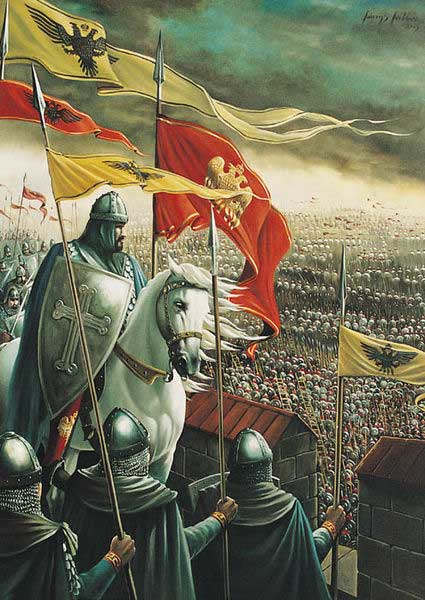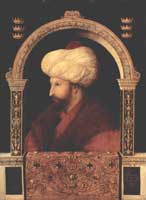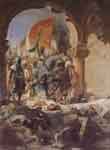.

The 1453 Siege of Constantinople (painted 1499)
The Fall of Constantinople was the conquest of the Byzantine capital by the Ottoman Empire under the command of Sultan Mehmed II, on Tuesday, May 29, 1453. This marked not only the final destruction of the Eastern Roman Empire, and the death of Constantine XI, the last Roman Emperor, but also the strategic conquest crucial for Ottoman rule over the Eastern Mediterranean and Balkans.
State of the Byzantine Empire

The Byzantine Empire around year 1400.
In the approximately 1,000 years of the existence of the Byzantine Empire, Constantinople had been besieged many times; it had been captured only once, during the Fourth Crusade in 1204. The crusaders, however, had not originally set out to conquer the Empire, and the Byzantines re-established themselves in the city in 1261. In the following two centuries, the much-weakened empire was gradually taken piece by piece by a new threat, the Ottoman Empire. In 1453 the "empire" consisted of little more than the city of Constantinople itself and a portion of the Peloponnese (centered on the fortress of Mystras); the Empire of Trebizond, a completely independent successor state formed in the aftermath of the Fourth Crusade also survived on the coast of the Black Sea.
Preparations
Mehmed, whose great-grandfather Bayezid I had previously built a fortress on the Asian side of the Bosporus called Anadolu Hisarı, now built a second castle outside the walls of Constantinople on the European side, which would increase Turkish influence on the straits. An especially relevant aspect of this fortress is its ability to prevent help from Genoese colonies on Black Sea coast reaching the city. This castle was called Rumeli Hisarı; Rumeli and Anadolu being the names of European and Asian portions of the Ottoman Empire, respectively. The new fortress is also known as Boğazkesen which has a dual meaning in Turkish; strait-blocker or throat-cutter, emphasizing its strategic position. The Greek name of the fortress, Laimokopia, also bears the same double-meaning. Meanwhile, Constantine XI tried to buy him off with gifts. The closing of the small mosques within Constantinople by Constantine XI and the pressures on Greek Muslims to convert back to Christianity formed the pretext for Mehmed to declare war.
Constantine appealed to Western Europe for help, but Pope Nicholas V was unwilling to support the Empire. Ever since the mutual excommunication of the Orthodox and Roman Catholic churches in 1054, the Roman Catholic west had been trying to re-integrate the east; the west now used this as a negotiating tactic, promising to send help if the Byzantines brought their church back into communion with Rome. Attempts had been made to do this after the Council of Florence and the Council of Basel, but the Orthodox population refused to support it. Pope Nicholas and many other western leaders made the decision not to support the Empire, although some troops did arrive from the city states of northern Italy.
The Byzantine army itself totalled about 7000 men, 2000 of whom were foreign mercenaries. The city also had fourteen miles of walls, probably the strongest set of fortified walls in existence at the time. The Ottomans, on the other hand, had a much larger force, numbering around 100,000, including 20,000 Janissaries. Mehmed also built a fleet to besiege the city from the sea.
The Ottomans employed a Hungarian engineer called Urban who was a specialist in the construction of cannons, which were still relatively new weapons. He built an enormous cannon, nearly twenty-seven feet (more than 8 m) in length and 2.5 feet (about 75 cm) in diameter, which could fire a 1200 lb (544 kg) ball as far as one mile. It was dubbed "the Basilic". Although the Byzantines also had cannons, they were much smaller and their recoil tended to damage their own walls. Urban's cannon had several drawbacks, however. It could hardly hit anything, not even as large as Constantinople; it took three hours to reload; the cannon balls were in very short supply; and the cannon collapsed under its own recoil after six weeks.
Another expert that was employed by the Ottomans was Ciriaco de Pizzicoli, also known as Ciriaco of Ancona, traveller and collector of antiquities.

Constantine XI, the last Byzantine Emperor at the battlements, dawn of the 29th May of 1453" 200 X 145 cm,- oil on canvas, 2003 by Iannis Nikou
Siege and final assault of the city
Mehmed planned to attack the Theodosian Walls, the intricate series of walls and ditches protecting Constantinople from an attack from the west, the only part of the city not surrounded by water. His army encamped outside the city on Easter Monday, April 2, 1453. For weeks Mehmed's massive cannon fired on the walls, but it was unable to sufficiently penetrate them, and due to its extremely slow rate of reloading the Byzantines were able to repair most of the damage after each shot. Meanwhile, Mehmed's fleet could not enter the Golden Horn due to the large chain the Byzantines had laid across the entrance. To circumvent this he built a road of greased logs across Galata on the north side of the Golden Horn, and rolled his ships across. This succeeded in stopping the flow of supplies from Genoan ships and demoralizing the Byzantine defenders, but did not help in breaching the land walls.
The Turks then sought to break through the walls by constructing underground tunnels in an effort to sap them. Many of sappers were Serbians sent from Novo Brdo by the Serbian Despot. They were placed under the rule of Zaganos Pasha. However, the Byzantines employed an engineer named Johannes Grant (who was said to be German but was probably Scottish), who had countertunnels dug, allowing Byzantine troops to enter the tunnels and kill the Turkish workers. Other Turkish tunnels were flooded with water. Eventually, the Byzantines captured and tortured an important Turkish engineer, who revealed the location of all the Turkish tunnels, which were then destroyed.
Mehmed offered to raise the siege for an astronomical tribute that he knew the city would be unable to pay. When this was declined, Mehmed planned to overpower the walls by sheer force, knowing that the Byzantine defenders would be worn out before he ran out of troops.
On the night of May 22 there was a lunar eclipse, which must have seemed a bad omen to the defenders of the city. On the morning of May 29 the attack began. The first wave of attackers, the bashi-bazouks, were poorly trained and equipped, and were meant only to kill as many Byzantine defenders as possible. The second assault, consisting largely of Anatolians, focused on a section of the Blachernae walls in the northwest part of the city, which had been partially damaged by the cannon. This section of the walls had been built much more recently, in the eleventh century, and was much weaker; the crusaders in 1204 had broken through the walls there. The Ottoman attackers also managed to break through, but were just as quickly pushed back out by the Byzantine defenders. The Byzantines also managed to hold off a third attack by the Sultan's elite Janissaries (ironically, most of the Janissaries had been Christian children who were captured by the Ottomans at an early age and trained as warriors), but the Genoan general in charge of the defense, Giovanni Giustiniani, was wounded in the attack, and the Greeks began to panic. Some historians suggest that the Kerkoporta gate in the Blachernae section had been left unlocked, and the Ottomans soon discovered this mistake (there was no question of bribery or deceit by the Ottomans; the gate had simply been overlooked, probably because rubble from a cannon attack had obscured or blocked the door). The Ottomans rushed in. Constantine XI himself led the last defense of the city, dying in the ensuing battle in the streets.
Aftermath
Mehmed had initially promised his troops they could loot the city for three days, in accordance with ancient military tradition. He eventually reconsidered and, while allowing looting, pillaging and raping to continue for weeks, he decided to not allow his soldiers to damage any of the structures to keep the city intact.
Mehmed waited until the area was secured and entered the city in a ceremonial procession where the local population brought him flowers in congratulations. His initial impression was that the city had fallen into disrepair, a trend that began after Constantinople was conquered in the Fourth Crusade.
In Mehmed's view, he was the successor to the Roman Emperor, but he was nicknamed "the Conqueror", and Constantinople became the new capital of the Ottoman Empire. Hagia Sophia was converted into a mosque, although the Greek Orthodox Church remained intact, and Gennadius Scholarius was appointed Patriarch of Constantinople.
Many Greeks fled the city and found refuge in the Latin West. Those Greeks who stayed behind were mostly confined to the Phanar and Galata districts. The Phanariots, as they were called, provided many capable advisors to the Ottoman sultans, but were seen as traitors by many Greeks.
The Morean (Peloponnesian) fortress of Mystras held out until 1460, where Constantine's brothers Thomas and Demetrius ruled, constantly in conflict with each other and knowing that Mehmed would eventually invade them as well. Long before the fall of Constantinople, Demetrius had fought for the throne with Thomas, Constantine, and their other brothers John and Theodore. Thomas escaped to Rome when the Ottomans invaded Morea in 1460. Demetrius expected to rule a puppet state, but instead he was imprisoned and remained there for the rest of his life. In Rome, Thomas and his family received some monetary support from the Pope and other western rulers as Byzantine emperor in exile, until 1503. In 1461 the autonomous Byzantine state in Trebizond fell to Mehmed.
Scholars consider the Fall of Constantinople as a key event ending the Middle Ages and starting the Renaissance because of the end of the old religious order in Europe and the use of cannon and gunpowder. The fall of Constantinople also severed the main overland trade link between Europe and Asia. As a result, more Europeans began to seriously consider the possibility of reaching Asia by sea - this would eventually lead to the European discovery of the New World.
Down to the present day, many Greeks have considered Tuesday (the day of the week that Constantinople fell) to be the unluckiest day of the week.
Constantinople 1453: the end of Byzantium, David Nicolle, Christa Hook
Further reading
- Steven Runciman: The Fall of Constantinople, 1453
. CUP. ISBN 0521398320
- Franz Babinger: Mehmed the Conqueror and His Time Princeton University Press. 1992. ISBN 0691010781
- David Nicole: Constantinople 1453
Osprey Publishing. 2000. ISBN 1 84176 091 9
- Richard Fletcher:The Cross and the Crescent
Punguin Group. 2005 ISBN: 0143034812
- Justin Wintle: The Rough Guide History of Islam Rough Guides
. 2003 ISBN: 184353018X
| Ancient Greece
Science, Technology , Medicine , Warfare, , Biographies , Life , Cities/Places/Maps , Arts , Literature , Philosophy ,Olympics, Mythology , History , Images Medieval Greece / Byzantine Empire Science, Technology, Arts, , Warfare , Literature, Biographies, Icons, History Modern Greece Cities, Islands, Regions, Fauna/Flora ,Biographies , History , Warfare, Science/Technology, Literature, Music , Arts , Film/Actors , Sport , Fashion --- |
Retrieved from "http://en.wikipedia.org/"
All text is available under the terms of the GNU Free Documentation License



